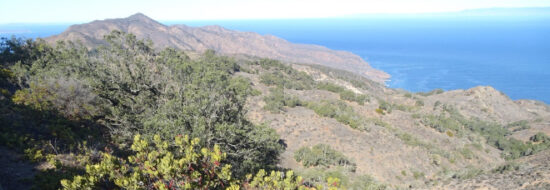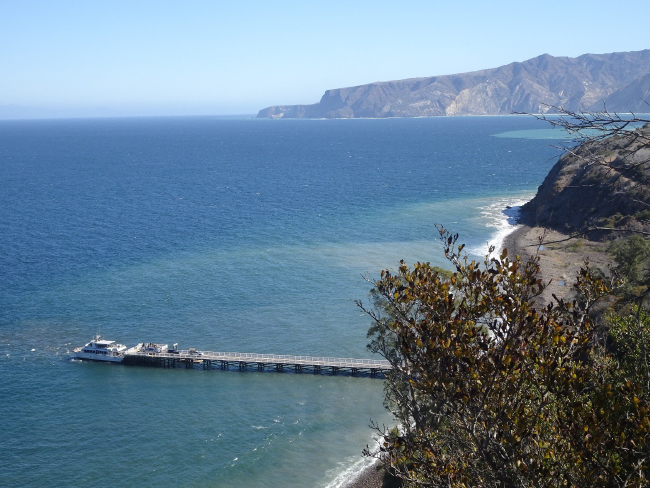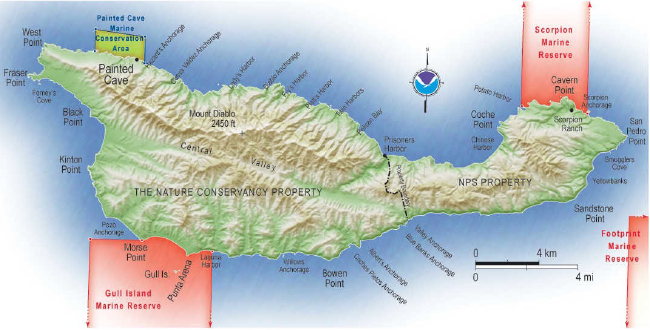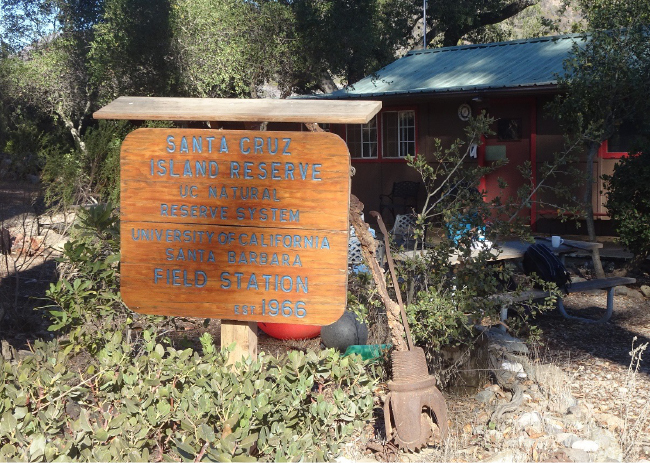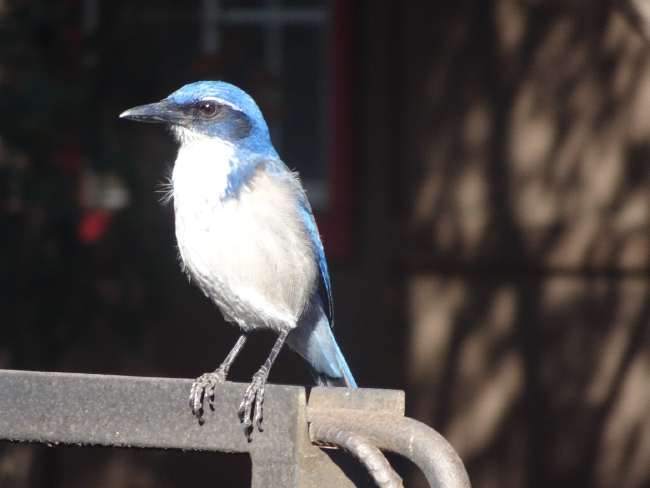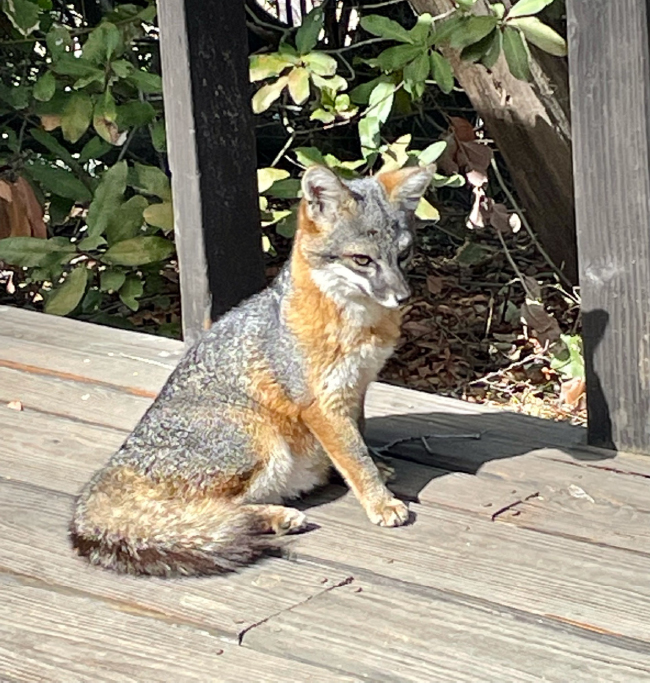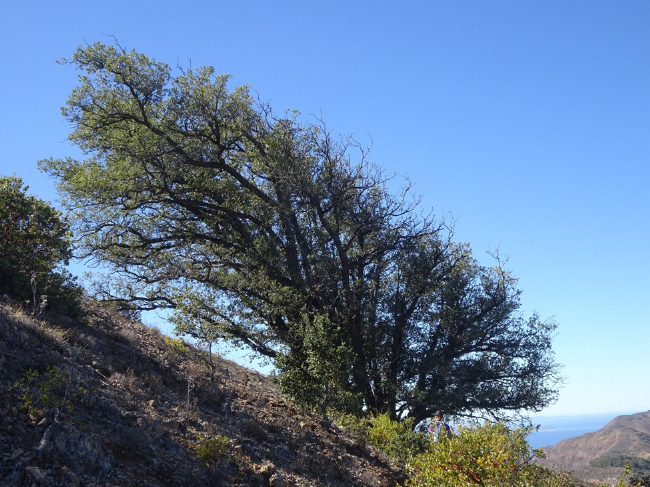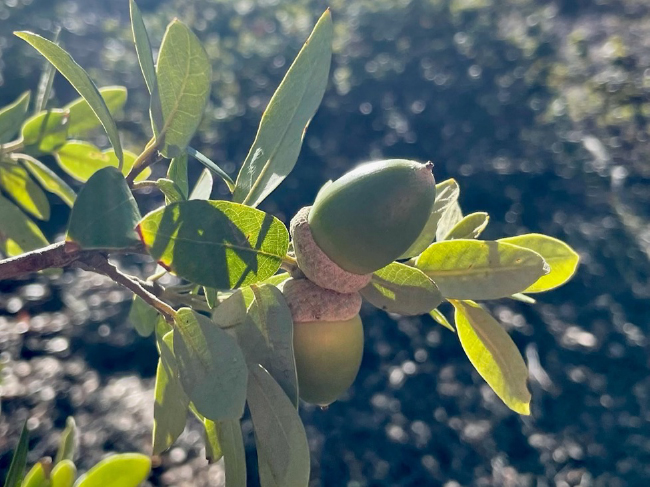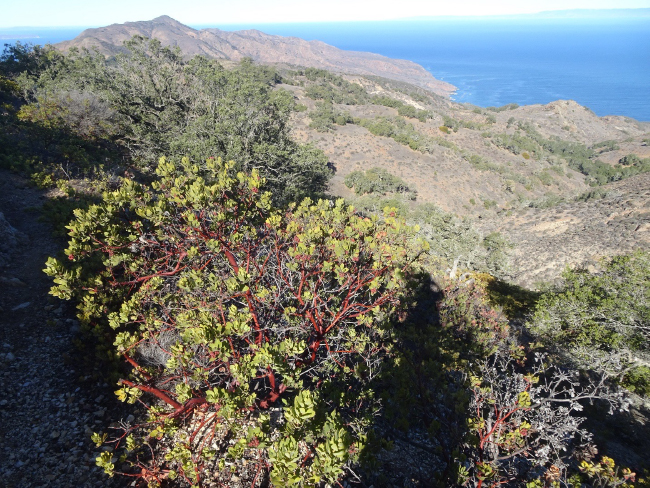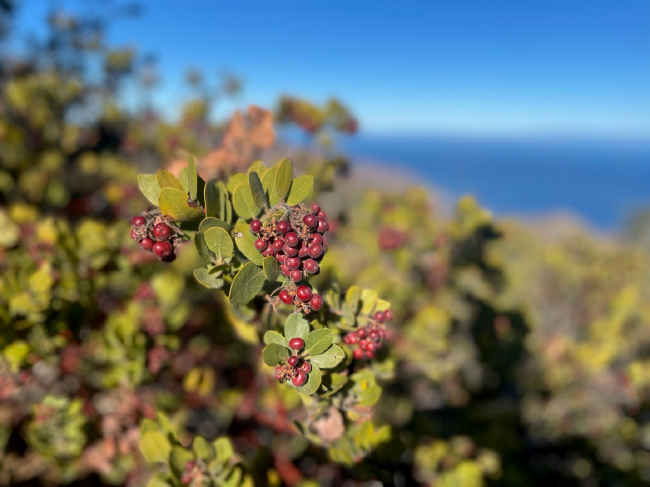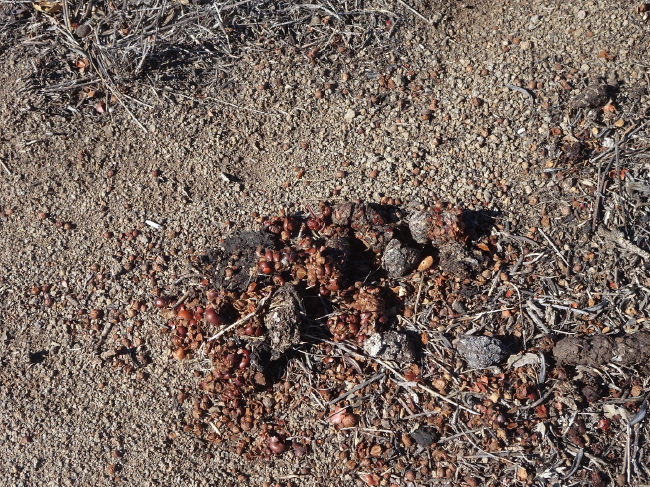Sunday, October 24th. Our reservations for the trip to Prisoners Harbor on the north shore of Santa Cruz Island had been made months ago. But the weather during the past week had forced Island Packers, the commercial concessionaire that provides transportation for visitors to the four northern islands within Channel Islands National Park, to cancel their trips on several days because of rough seas and fierce northwest winds. We were packed and ready; would we go? We followed the protocol from Island Packers and called their trip-status number at 5:30 AM from our hotel room near Ventura Harbor: all trips were on today! We went out to a nearby Starbucks to pick up breakfast sandwiches, almond croissants, and large coffees. I’m moderately prone to seasickness, but figured it was better to have something in my stomach to come up, if the sea conditions on the crossing dictated that. And the coffee was a definite “necessary.” At 8 AM we were waiting at the dock to load our week’s-worth of food and gear onto the Island Explorer, on a still, sunny morning. We were off on schedule at 9 AM, on a beautiful sunny morning, for the 25-mile, hour-and-a-half boat ride to the island.
The Island Explorer, a 65-foot catamaran-design vessel that can carry 145 passengers, was nearly full. Everyone was wearing masks because of California and company covid protocols. Most passengers were only going for the day to Scorpion Anchorage on the east end of the island for hikes or kayaking trips. A few of us were going on to Prisoners Harbor, most for longer stays so with more gear stored below. Although there was some wind and exhilarating bow-splash as we went west, the seas weren’t such as to provoke seasickness. Anacapa Island and one of the still-pumping oil platforms in the Santa Barbara Channel passed as silhouettes against a silver sea to the southeast. Most of the day trippers got off at Scorpion and we went on to Prisoners Harbor. Our gear was unloaded off the boat and loaded into an old black Toyota Tacoma, and we were taken up the rocky dry river valley road to the field station of the University of California at Santa Barbara’s Santa Cruz Island Reserve (SCIR) by Dr. Lyndal Laughrin, the director-emeritus of the station, who still lives nearby.
Thanks to the calm seas breakfast had stayed down, but it was lunchtime now—and apparently the island’s time to introduce us to two of its most iconic, endemic, non-human species, one a bird, one a mammal. The first self-introduction was by the island scrub-jay (Aphelocoma insularis). As soon as we sat down at the picnic table on the deck at the back of the main building and brought out our sandwiches and chips, an aggressive jay appeared, hopping on the table and inviting a handout—or threatening theft.
While shooing off the jay, a tiny, nonchalant island fox (Urocyon littoralis) came up on the deck nearby. It seemed to completely ignore us and settled down for a lunchtime siesta in the sun a few feet away. Its behavior was surprising and somewhat disconcerting; this was just how a pet cat or dog would claim its favorite spot in its owner’s house. This was really a wild fox?
The same jay—named “Jay-Jay“ by the daughter of the director of the SCIR, Dr. Jay Reti—was our constant companion at every outdoor meal or happy-hour for the rest of our stay. The foxes would appear ephemerally around the station, seemingly oblivious to our presence. But this was a nature reserve, after all, and they claimed it as their territory according to island fox protocol: the picnic tables on the deck and other points around the building were prominently marked with their poop-piles. We met many more jays and many more foxes on our forays around the island, and they continued to endear themselves throughout our stay.
The jay was big and aggressive, the fox small and demure. Both personalities were perfect emissaries from the island. The fox and the jay embody and illustrate here, on what have been called “California’s Galapagos,” some of the biogeographical patterns often seen most clearly on islands—patterns that struck Charles Darwin so forcefully on Ecuador’s Galapagos Islands in 1835 that they seem to have forced him to develop his theory of evolution by natural selection, which he laid out much later, in 1859, in On the Origin of Species.
One fact that the archipelago thrust upon Darwin is that the relative isolation of populations of a species enables and encourages their ecological and evolutionary divergence and eventual speciation. A suite of closely related finches found there, now referred to as “Darwin’s finches,” was exhibit number one. After colonizing an island, a pair or small group of finches (or any other species) is more or less reproductively isolated, breeding among themselves in that isolated place. That allows the forces of natural selection to adaptively shape their population to that place, independently of the forces that shaped or constrained their mainland ancestors, or even their cousins on other nearby islands. Santa Cruz Island and the seven other islands of California’s Galapagos abound in examples as surprising and illuminating as the finches and other examples from the other Galapagos.
_______
Before diving in, I want to insert a short preface to explain why I think these stories of evolution and ecology on Santa Cruz Island are important. First, because they’re fascinating and fun, and the science is fairly simple. You don’t have be a scientist of any kind to understand this stuff. They illustrate well one of the lessons that I think biosphere reserves have to teach, which is that despite all we have learned, there is still much we don’t know. The need for ecological research is never-ending, and it can inform the restoration of damaged ecosystems and how we manage them into the future. But the examples I present here also speak to another lesson of biosphere reserves: worldviews—how we think about the human-nature relationship—matter, because they influence how we act. These little examples of evolutionary ecology on Santa Cruz Island demonstrate some key ecological principles: adaptation, diversity, interdependence, symbiosis, mutualism, and resilience. Although derived from science, these same principles must also be incorporated into the philosophy and ethics of the new ecological worldview we desperately need to save our imperiled planet.
________
To understand why the term “California’s Galapagos” is appropriate, we should first consider the geological history of these islands. I’ll focus on the four northern Channel Islands, and for them, only on relatively recent history. Sixteen thousand years ago—a relative eyeblink in evolutionary time—at the end of the most recent glacial episode of the Pleistocene Ice Age, when huge amounts of water were stored as continental ice sheets, the now-separated four northern Channel Islands of San Miguel, Santa Rosa, Santa Cruz, and Anacapa were a single large island, which has been called Santa Rosae (or sometimes Santarosae) Island. At that time, Santa Rosae was estimated to be only a handful of miles from the nearest point on the mainland, which would have been southwest of modern-day Oxnard. But the big island of Santa Rosae had been there much, much longer—the top of a mountain ridge thrust up by the tectonic tantrum that began around four million years ago and created the Transverse Ranges and California Bight (described in my previous story posted here). Plenty of time, in other words, to be colonized by plants and animals from the mainland—whether they arrived by riding on intact pieces of it that broke away, or whether they flew, blew, rafted, or swam there.
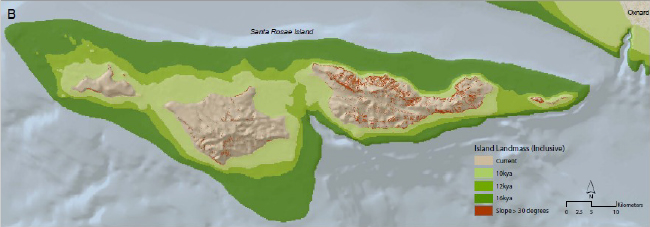
Perhaps a place to begin this story is with the pygmy mammoth, Mammuthus exilis, a classic example of the evolution of small body size, or “dwarfism,” on islands—a relatively common evolutionary phenomenon worldwide. Skeletons of this tiny mammoth (”exiled” to the Channel Islands as its scientific name suggests) were first excavated on Santa Rosa Island beginning in the 1920s. These Ice Age elephants stood about as tall as a human, in contrast to their mainland cousins, the Columbian mammoth (Mammuthus columbi), which were twice as tall, about the size of modern African elephants. Just think—mounting a pygmy mammoth for a ride would have been about the same as mounting a small horse, even a pony! Somewhere between 40,000 and 20,000 years ago, when the skyline of the super-island of Santa Rosae was only a few miles offshore and the smell of its vegetation may have wafted in on west winds, the hypothesis is that Columbian mammoths swam over and colonized the island. Swimming elephants aren’t a stretch of the imagination. African elephants are known to be good swimmers; they have been documented swimming 15 miles across Lake Kariba, which flooded the Zambezi Valley between Zimbabwe and Zambia when the Kariba Dam was constructed in 1959, interrupting what must have been a common elephant migration route.
Island-evolved dwarfism is hypothesized to result from selective pressure on isolated populations where food supplies and migratory ranges are limited and predators fewer. Smaller body size theoretically allows for larger populations, and larger populations are more resistant to extinction from random environmental events.
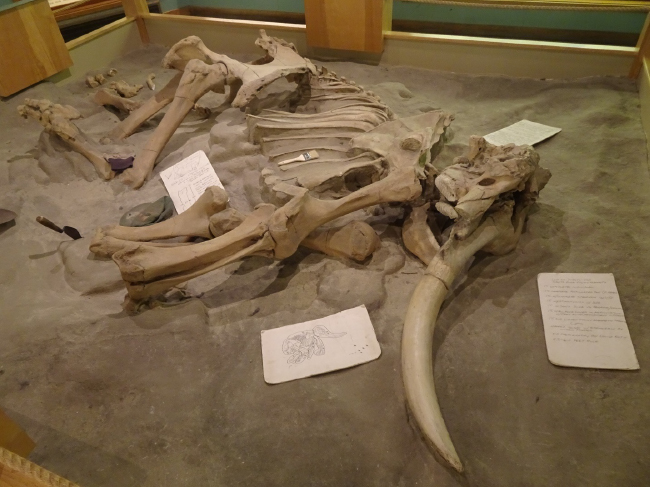
Mammoths—both on the mainland and on the Channel Islands—disappeared by around 12,000 years ago. One hypothesis places the blame on overhunting by paleo-humans. Pygmy mammoth bones, some of them charred, have been found in middens on San Miguel and Santa Rosa Islands (Schoenherr et al., 1999, p. 264, 277), evidence that early humans hunted this species. No direct evidence, like stone spear points stuck in mammoth ribcages, have been found so far. Another explanation for their extinction focuses on the fact that Earth’s climate was changing rapidly then, as the Ice Age faded. Some scientists speculate that a combination of climate change and human hunting combined to cause the extinction of mammoths and many other species of large Ice Age mammals, the so-called “Pleistocene megafauna.”
_______
What about our little friend, the island fox? The fox is another, still-living, example of island dwarfism. It is found only on six of the eight Channel Islands, but not on the California mainland. Its closest relative is the gray fox (Urocyon cinereoargenteus), which is found throughout the southern U.S., Mexico, and Central America. But the island fox is one-third smaller than the gray fox; standing about a foot high and weighing only four or five pounds, it is about the size of a house cat.
The explanation for the evolution of small size in the island fox is similar to that for the dwarf mammoth. It is the largest terrestrial mammal on the islands, and the top predator. Its food consists of mice, lizards, insects, and fruits such as those of manzanitas. Even the largest of the islands, Santa Cruz, seems only able to support a population of a few thousand foxes at most. These ecological factors may explain why island foxes evolved smaller size. The absence of predators may also explain why island foxes are active during the day, unlike their mainland congener, the gray fox, which is nocturnal.
How and when did the foxes get to the seven Channel Islands where they are now found? It’s a fascinating—and scientifically unresolved—story. Well-defined subspecies, based on both genetic and physical characteristics, exist on each of the islands. Foxes have differentiated to a greater degree than any other mammal found on the islands, which suggests that populations on each island have been isolated for a long time. Most researchers believe that foxes first arrived on the super-island of Santa Rosae during the last glacial maximum, sometime between about 25,000 and 16,000 years ago—before the first humans arrived (by or before 13,100 years ago). Founding foxes would have had to cross only a few miles of water from the mainland near present-day Ventura; it is speculated that they rafted on floating vegetation, since foxes aren’t known as strong swimmers. The evolution of small size may have begun then. By about 9,500 years ago, sea level had risen and the four northern islands of former Santa Rosae were separated; distinct subspecies of island foxes evolved on San Miguel, Santa Rosa, and Santa Cruz Islands. Anacapa was apparently not big enough to sustain them.
Foxes show up much later in the archeological record on three of the southern Channel Islands, first San Clemente Island about 3,400 years ago, and even later on San Nicolas and Santa Catalina. It is thought that the foxes were transported to the southern islands by humans. The indigenous inhabitants of the Channel Islands must have had some kind special relationship with the foxes; fox skulls have been found with several human burials on Santa Cruz and Santa Rosa Islands, indicating that they may have been viewed as “spirit guides” or “dream helpers” of those individuals (Collins, 2009, p. 25).
But this scenario for island foxes in not accepted by all researchers. New methods of determining the age of the oldest fox bones from Santa Rosa Island (Rick, et al., 2009) dated them to around 6,500 years ago, which would be after known human presence on the islands, rather than to an earlier carbon-14 date of 16,000 years ago, which was potentially before the first humans arrived. Based on this new dating, these authors suggested that humans could have transported foxes to all of the islands, but qualified their speculation by saying that further paleontological, archaeological, and genetic studies are needed to answer the question.
How fast can selection change the size of species in the dog family Canidae, to which foxes belong? The domestic dog, Canis familaris, exhibits a greater diversity of body size than any other species of terrestrial vertebrate; dogs range from six-inch-long Chihuahuas to eight-foot-long Irish wolfhounds. Dogs have only been domesticated (from wolves) for around 14,000 years, and the diversity seen in the more than 400 genetically distinct breeds has been the result of selection by humans over a much shorter time span (Akey, et al., 2010). Research on the genetics of body size in dogs (Sutter, et al. 2007) has shown that a single genetic variant in the insulin-like growth factor 1 gene is found in all small breeds and is nearly absent in large breeds, suggesting that it alone is a major determinant of size. This kind of evidence suggests that over the course of some thousands of years, island foxes easily could have evolved to be one-third smaller than the gray fox, no matter how or when they first arrived on the islands.
The fact that island foxes were found buried with humans and were transported from island to island—certainly from the northern to the southern Channel Islands—by humans raises the interesting question of whether they were “domesticated” and kept as pets, or kept for their fur, for spiritual reasons, or were simply captive “wild” foxes. The behavior of the fox who appeared at lunch on our arrival at the research station at least shows that modern “wild” foxes are quite tame and unafraid of people. That could be explained by the fact that they evolved on these islands, with no predators, and therefore lost any fear of humans or larger animals. Or, the explanation could be that they had once been tamed or domesticated by humans, losing some natural fear of people, and then become feral again on the islands. Or maybe the explanation could be a combination of the two. Interesting experiments on the genetics of tameness and fear of humans in the European red fox (Vulpes vulpes) are likely to be relevant in answering this question about the island fox (Saey, 2018; Buehler, 2019) … but that’s another—long—story that I can’t go into here.
_______
The island scrub-jay is found only on Santa Cruz Island, and nowhere else on Earth—a single-island endemic species, and the only island-endemic bird species in North America. It is related to the California scrub-jay (Aphelocoma californica), which is common and widely distributed on the mainland, but the island scrub-jay is about one-third larger, illustrating a fairly common pattern of the evolution of “giantism” on islands. Genetic analysis indicates that this species diverged from its mainland relative, the California scrub-jay, about 150,000 years ago (Delany, et al., 2008).
One morning as we hiked toward Mount Diablo, the highest point on Santa Cruz Island, we found a windswept cluster of oaks along the mostly treeless ridge. It was bustling with island scrub-jays, harvesting the just-ripe acorns. Gangs of jays seemed to be competing here. I saw several tussles between jays when an acorn being plucked above had dropped to the ground. And when a jay had an acorn in its beak, it sailed off downslope in one of two different directions: some jays glided down to the northeast, but others decidedly northwest. Were these extended-family groups working together, I wondered?
The sociobiology of the island scrub-jays is interesting stuff: they are relatively long-lived, living up to 20 years; they are monogamous and may stay with the same mate for life; they are nonmigratory, and maintain year-round territories in island chaparral vegetation dominated by oaks, especially the endemic island scrub oak (Quercus pacifica). Island scrub jays depend on acorns for food, and when acorns are ripe, they harvest them, transport them in their bills for varying distances, and hide them for later consumption in spatially dispersed caches. Despite the incredible spatial memory of these jays, some caches are never consumed, either because they are forgotten or because of the demise of the jay that cached them, and they germinate, starting a new tree. Thus, the jays have evolved a mutually beneficial symbiosis with oaks: the jays depend on the oaks for food, and the oaks on the jays for a sophisticated system of high-quality seed dispersal. But the system is a delicate coevolutionary dance, favorable when in balance, but risky for either species when out of balance. The oak’s strategy for keeping the balance is to “mast”—that is, to produce large crops of acorns one year and hardly any in other years, so that jay populations can’t build up to a level that could consume so many that oak recruitment would be suppressed. The jay’s strategy for keeping the balance is to defend territories (where oaks are producing acorns or acorns from previous-year crops are cached) all year long against their fellow jays. This territorial behavior limits population growth in the jays to the carrying capacity of the territory. Large body size and longevity in the jays may both have been positively selected for to facilitate such territorial behavior.
Plants as well as animals illustrate the evolutionary patterns of island evolution and endemism, of course. The oaks on the ridge were island live oak, Quercus tomentella. This species is found on only on three of the northern Channel Islands (all except San Miguel) and two of the southern islands (Santa Catalina and San Clemente). It is closely related to canyon live oak (Quercus chrysolepis), which is widely distributed on the California mainland and also found on Santa Cruz Island in some places.
Fossils seem to show that the island live oak was once also found on the mainland, and so some botanists might call it a “relict” species—the last small populations of a formerly more abundant species now hanging out and hanging on in isolated, backwater ecosystems like the Channel Islands. But hey—to an island oak thriving on a north-facing ridge below Diablo Peak on Santa Cruz Island, with island jays going crazy harvesting and caching your crop of acorns—some of which will get forgotten and seed your descendants nearby—life is good!
Evolution is a creative, flexible, ongoing process. California is the center of biological diversity of oaks in North America, and the palette of oak genotypes painted over this part of the continent over the past tens of millions of years has adapted, diversified, speciated, evolved, hybridized, and thereby survived all of the geological, geographic, and climatic changes our dynamic old Earth could throw at it. Life is good as long as the creativity of evolution and symbiosis can outrun the challenges posed by our dynamic planet.
Ranching activities began on Santa Cruz Island in the 1850s, and large flocks of sheep, herds of feral pigs, and grazing by horses and cattle destroyed oak chaparral and suppressed oak reproduction. Following the removal of these introduced, exotic species from the island beginning in the mid-1980s, native vegetation has rebounded dramatically. Oak recovery has enabled the island scrub-jay population to increase by an estimated 20-30 percent, in a positive feedback process (Caldwell, et. al., 2013; Sillett, et al., 2012, p. 1997). Maybe we could think of the jays as oak “farmers,” lured by the oak’s abundant acorns in mast years into propagating and spreading them. It’s not really that different than the evolutionary game played by wheat, rice, maize, potatoes, and other domesticated crops, which have tricked one familiar animal species into eating and spreading them, dramatically increasing the evolutionary success of those plants.
And the future of the jays? There are fewer than 3,000 individuals of this isolated species, and its small range and population size make it vulnerable to natural disasters and vegetation shifts caused by climate change (Morrison, et al, 2011; Sillett, et al., 2012).
Research on the symbiotic mutualism of endemic oaks and the endemic island scrub-jay provides an example of the link between research and restoration that was so obvious at Cascade Head, in Oregon, where estuarine restoration enabled discoveries about salmon life history and ecology that would not have been possible otherwise. There, restoring salt marsh habitat had a positive feedback effect on salmon populations. On Santa Cruz Island, oak restoration had a synergistic effect on jay numbers. And research on Santa Rosa Island is beginning to show how restoring the symbiosis between oaks and jays can affect ecosystem functioning and the ecosystem services it creates. There, island oak groves on highland ridges capture fog and increase water inputs to soils and watersheds—essentially functioning as cloud forests. Between 1994 and 2015, fourteen oak groves on the island expanded by an average of about 37 percent (Woolsey, et al., 2018). This must be due only to the elimination of herbivory by sheep, pigs, and cattle, and not the assistance of island jays, which no longer exist on Santa Rosa Island—although they may have been found there until the late 19th century (Collins, 2009, p. 39). The restoration of vegetation and the ecohydrological role it plays raises intriguing questions about human habitation of the islands; maybe these islands weren’t as dry as they seem now and there was more permanent surface water and springs than we can guess, having seen them only in a state damaged by overgrazing.
Some recent research that I can’t resist summarizing here takes the evolutionary story of island scrub-jays to a new level. In a paper titled “Islands within an island: Repeated adaptive divergence in a single population,” published in the journal Evolution in 2015, Kathryn Langin and her coauthors report that the jays on Santa Cruz Island have evolved adaptations to different vegetation communities on the island, as if those habitats were “islands” themselves. Jays from the three separate areas where Bishop pine (Pinus muricata) is found on the island had beaks that differed in size and shape—longer, shallower, and thus more efficient for extracting pine seeds from cones, but less efficient for hammering and prying open acorns—than jays found in the more widespread areas of oak chaparral.
Bill morphology is inherited, so this is a kind of microevolution and microadaptation to local conditions at a small spatial scale. The social behavior of the island scrub-jays must enable such microevolution and adaptation. Their food resources are limited, they are competitive and territorial, and viable breeding territories are scarce. Consequently, the offspring of a pair holding a breeding territory (remember, they are long-lived and monogamous) don’t have much of anywhere else to go, and hang around “home” until they can inherit the property, so dispersal and gene flow is limited, making home territory a kind of island.
Bishop pine is considered a relict species on the Santa Cruz—still hanging on in the face of a changing climate, but having been much more common in the wetter and cooler Pleistocene, the sparse stands that remain seem to be tough survivors. Although still reproducing—we saw lots of baby pines in the central stand on our hike to Pelican Bay, for example—they were poor cousins to the rich, fog-nourished Bishop pine forests I’d seen on Point Reyes’s Inverness Ridge in June, on my research trip to the Golden Gate Biosphere Reserve. Bishop pines are fire-adapted, with woody, “serotinous” cones, whose cone scales are sealed shut with resin that melts and opens with the heat of a fire, seeding a new generation of the species onto a burned landscape. Sometimes, though, high temperatures cause the cones to open without fire, as happens on Santa Cruz Island, where, at least now, fires are uncommon. Island scrub-jays inhabiting the remaining pine habitats on the island have been observed patrolling the pines for open cones and harvesting their pine nuts.
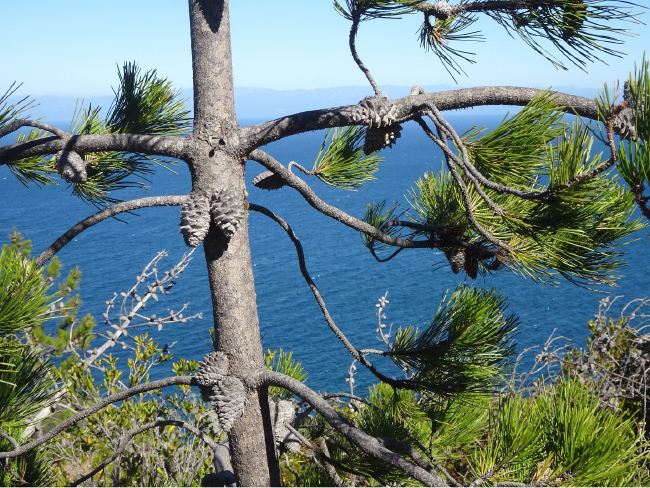
_______
Finally, one more story I can’t resist. Manzanitas are members of the heath family, Ericaceae, the same family to which many familiar edible berries belong, such as blueberries, cranberries, and huckleberries. They typically have smooth, red bark, and the look of their tiny fruits led to their common name, from Spanish, meaning “little apple.” All are members of the genus Arctostaphylos, and of the 105 recognized species, 95 are found in California, either in Mediterranean-climate chaparral or colder mountain areas. Many species grow in habitats that experience frequent fires. Two tree-like species of manzanita are found only on Santa Cruz Island: Santa Cruz Island manzanita, Arctostaphylos insularis, and McMinn’s manzanita, Arctostaphylos viridissima. A third species Arctostaphyos tomentosa, the island manzanita, has two subspecies, both found on Santa Cruz, and also on Santa Rosa.
The island manzanita has the ability to resprout from underground roots after a fire, whereas the more tree-like species cannot, but must regenerate from seeds. It is presumed that, like many other fire-dependent chaparral plants, the seeds of those manzanitas can lie dormant in the soil until they experience the heat of a fire or compounds leached from charcoal by water following a fire that are able to stimulate germination (Schoenherr, et al., 1999, p. 296). But I suspect another possibility in this case. In his poem “Control Burn,” Gary Snyder (Earth House Hold, New York: New Direction, 1969, p. 4), noted that
manzanita seeds will only open
after a fire passes over
or once passed through a bear
There are no bears on the Channel Islands, but I mentioned earlier that island foxes mark their territory with scat piles—such as on the picnic table on the deck at the research station. Their territorial markings were common wherever one of their distinctive tiny trails—clear, well-used paths through the grasses—crossed a human road or trail. And these scat cairns were often full of manzanita seeds. If passing through the gut of a bear can stimulate manzanitas to germinate, my guess is that a trip through an island fox could also. If so, there may be a seed-dispersal symbiosis between foxes and manzanitas similar to that of jays and oaks.
For related stories see:
- Ecological Explorations at the Edge of the Continent, June 2021.
- More Ecological Explorations at the Edge of the Continent, October 2021.
Sources and other links:
- Island Packers
- Channel Islands National Park
- Santa Cruz Island Reserve, UC Santa Barbara Natural Reserve System
- Santa Cruz Island Preserve, The Nature Conservancy
- Oral history interview with Dr. Lyndal Laughrin by Dewey Livingston, 2011
- Schoenherr, Alan A., C. Robert Feldmeth, and Michael J. Emerson. 1999. Natural History of the Islands of California. University of California Press: Berkeley, CA.
- Pygmy Mammoth, National Park Service Channel Islands National Park
- Island Scrub-Jay
- Island dwarfism and giantism
- Island Fox, National Park Service
- Rick, Torben C., et al. 2009. “Origins and antiquity of the island fox (Urocyon littoralis) on California’s Channel Islands.” Quaternary Research 71 (2009) 93–98.
- Collins, Paul W. 2009. “Historic and Prehistoric Record for the Occurrence of Island Scrub-Jays (Aphelocoma insularis) on the Northern Channel Islands, Santa Barbara County, California.” Santa Barbara Museum of Natural History Technical Reports – No. 5.
- Akey, Joshua M., et al. 2010. “Tracking footprints of artificial selection in the dog genome.” PNAS, 107: 1160-1165.
- Sutter, Nathan B., et al. 2007. “A Single IGF1 Allele Is a Major Determinant of Small Size in Dogs.” Science, 316: 112-115.
- Saey, Tina Hesman. 2018. “The first detailed map of red foxes’ DNA may reveal domestication secrets.” Science News, August 6, 2018.
- Buehler, Jake. 2019. “Russian foxes bred for tameness may not be the domestication story we thought.”Science News, December 31, 2019.
- Delany, Kathleen Semple, et al. 2008. “Genetic Divergence and Differentiation within the Western Scrub-Jay (Aphelocoma californica).” The Auk, 125: 839–849.
- Caldwell, et al. 2013. “Reproductive Ecology of the Island Scrub-Jay.” Condor 115: 603-613.
- Pesendorfer, Mario B. et al. 2016a. “Scatter-hoarding corvids as seed dispersers for oaks and pines: A review of a widely distributed mutualism and its utility to habitat restoration.” The Condor, 118: 215–237.
- Pesendorfer, Mario B., et al. 2016b, “Context-dependent seed dispersal by a scatter-hoarding corvid.” Journal of Animal Ecology, 85: 798-805.
- Sillett, T. Scott, et al., 2012. “Hierarchical distance-sampling models to estimate population size and habitat-specific abundance of an island endemic.” Ecological Applications, 22: 1997-2006.
- Morrison, Scott A., et al. 2011. “Proactive Conservation Management of an Island-endemic Bird Species in the Face of Global Change.” BioScience, 61: 1013–1021.
- Jay Woolsey, et al. 2018. “Regeneration and Expansion of Quercus tomentella (Island Oak) Groves on Santa Rosa Island,” Western North American Naturalist, 78: 758-767.
- Byers, Bruce A. 2020. The View from Cascade Head: Lessons for the Biosphere from the Oregon Coast (Oregon State University Press).

